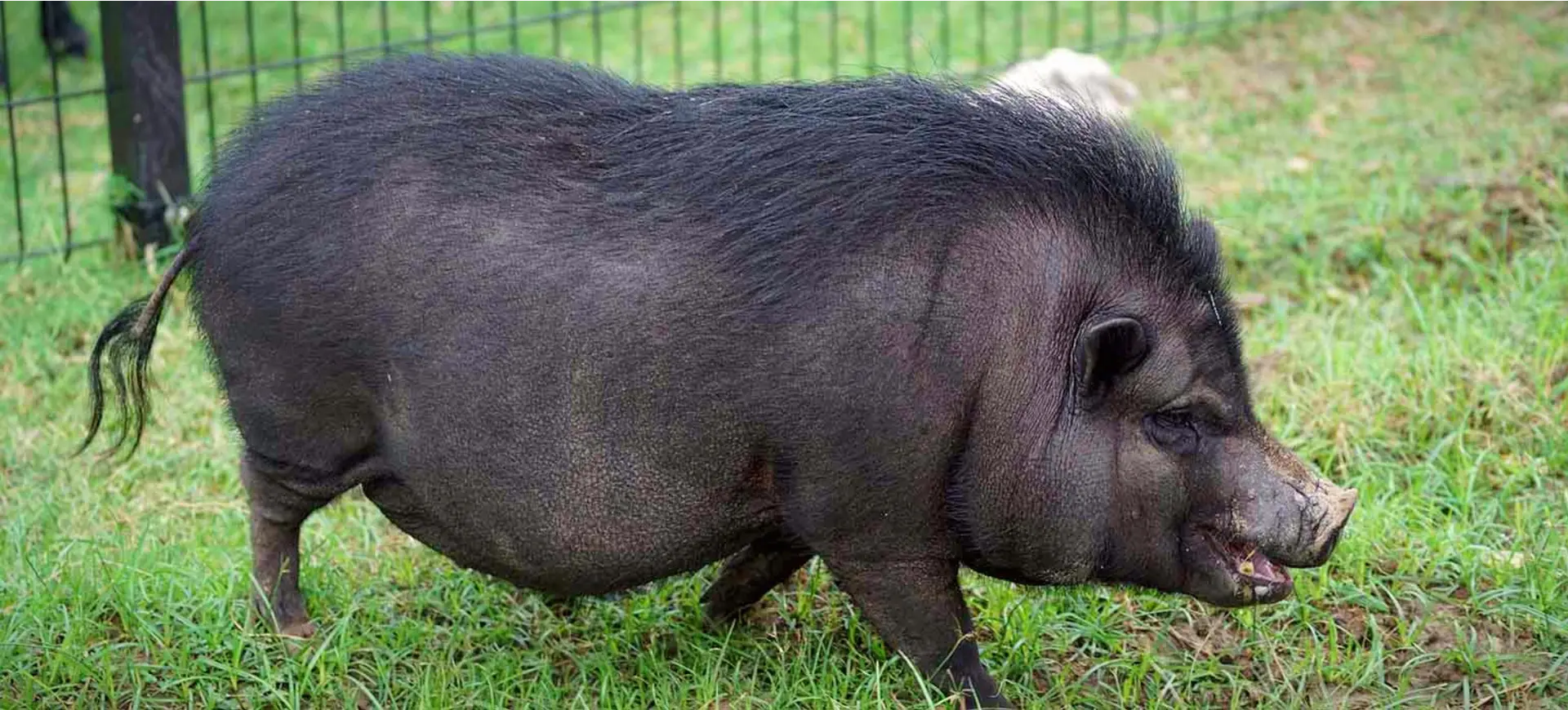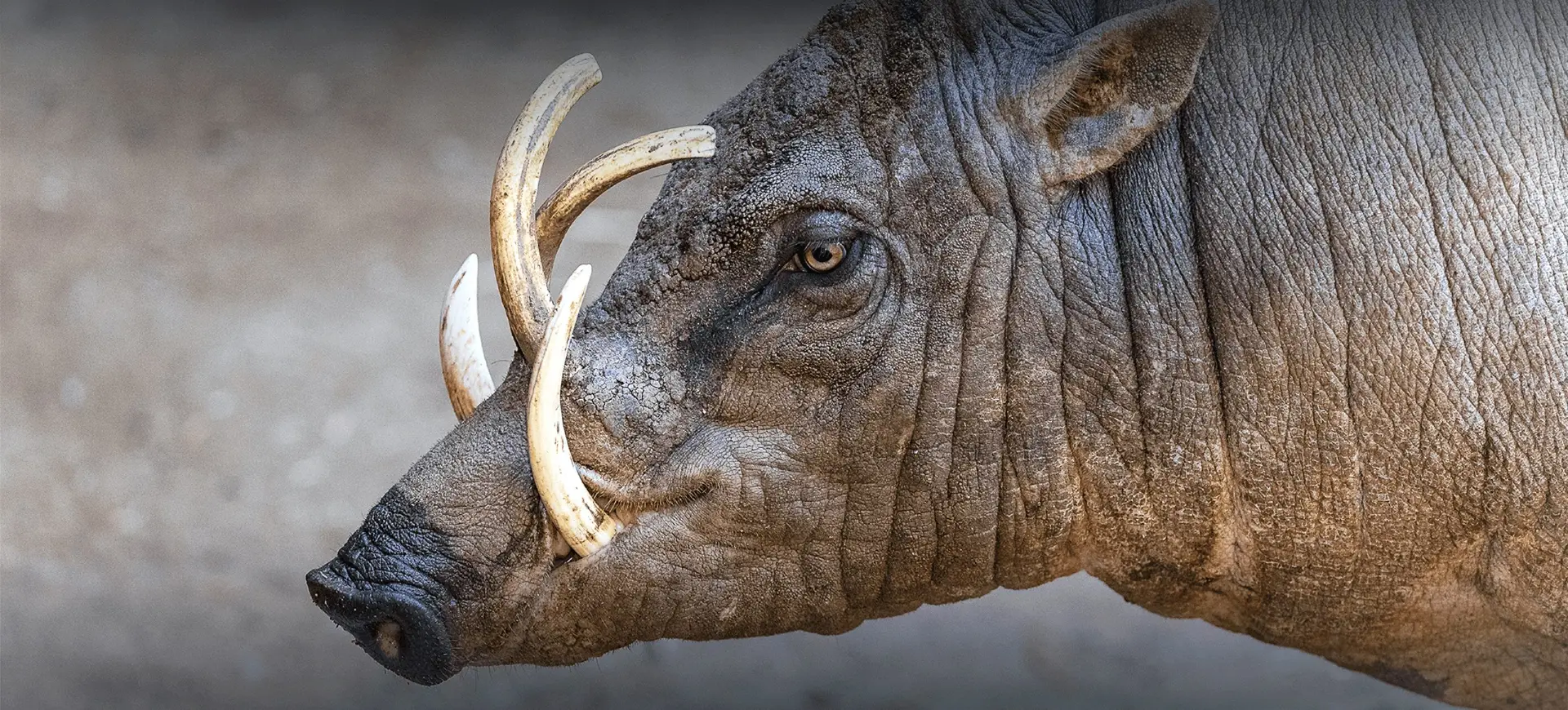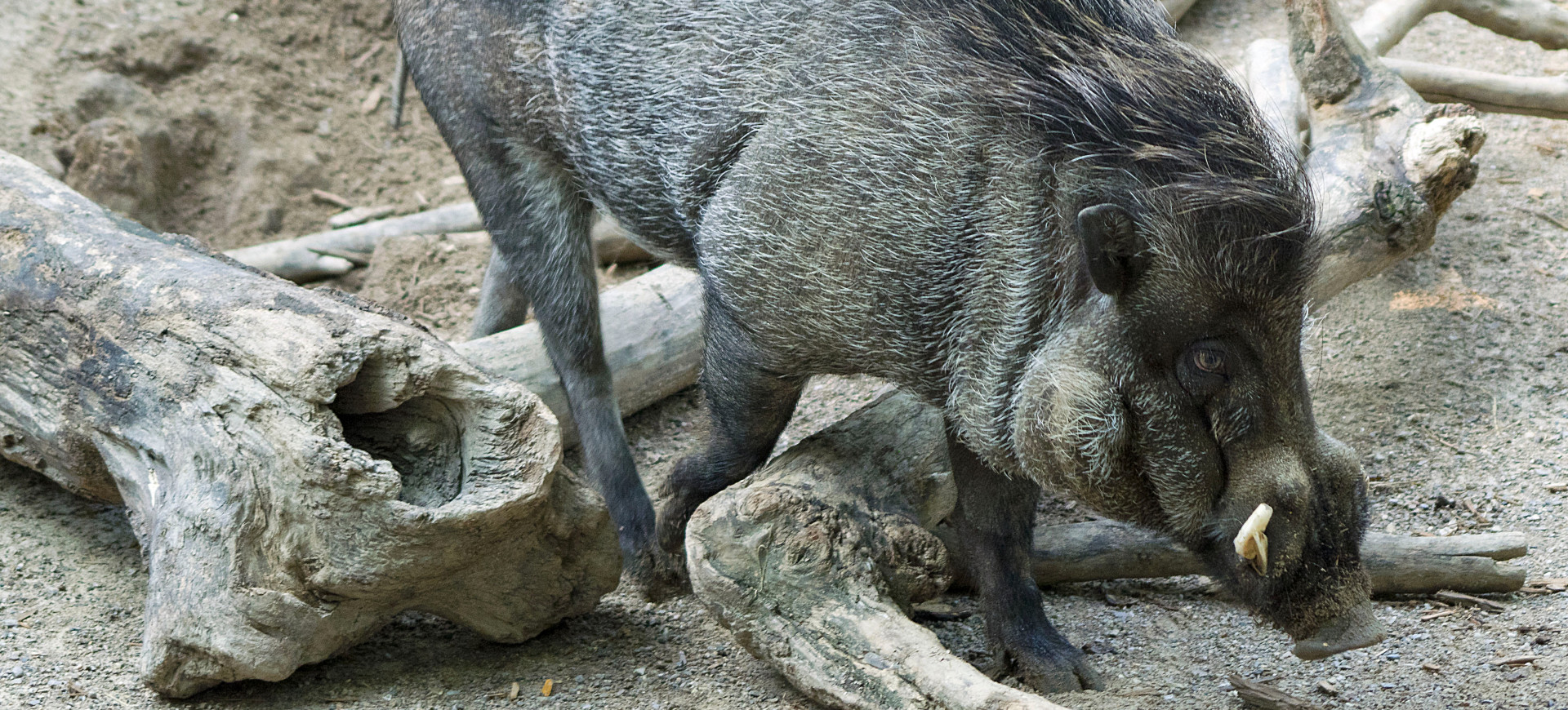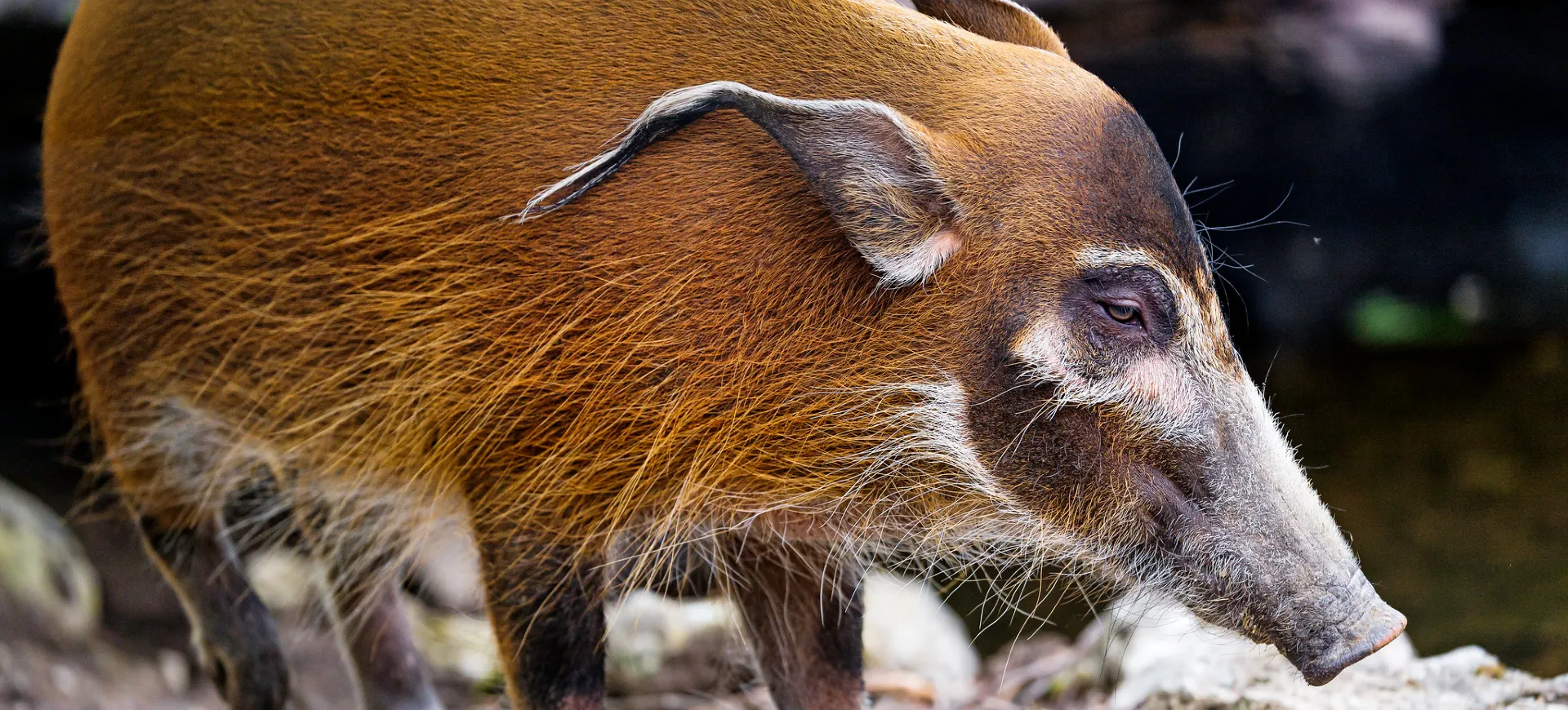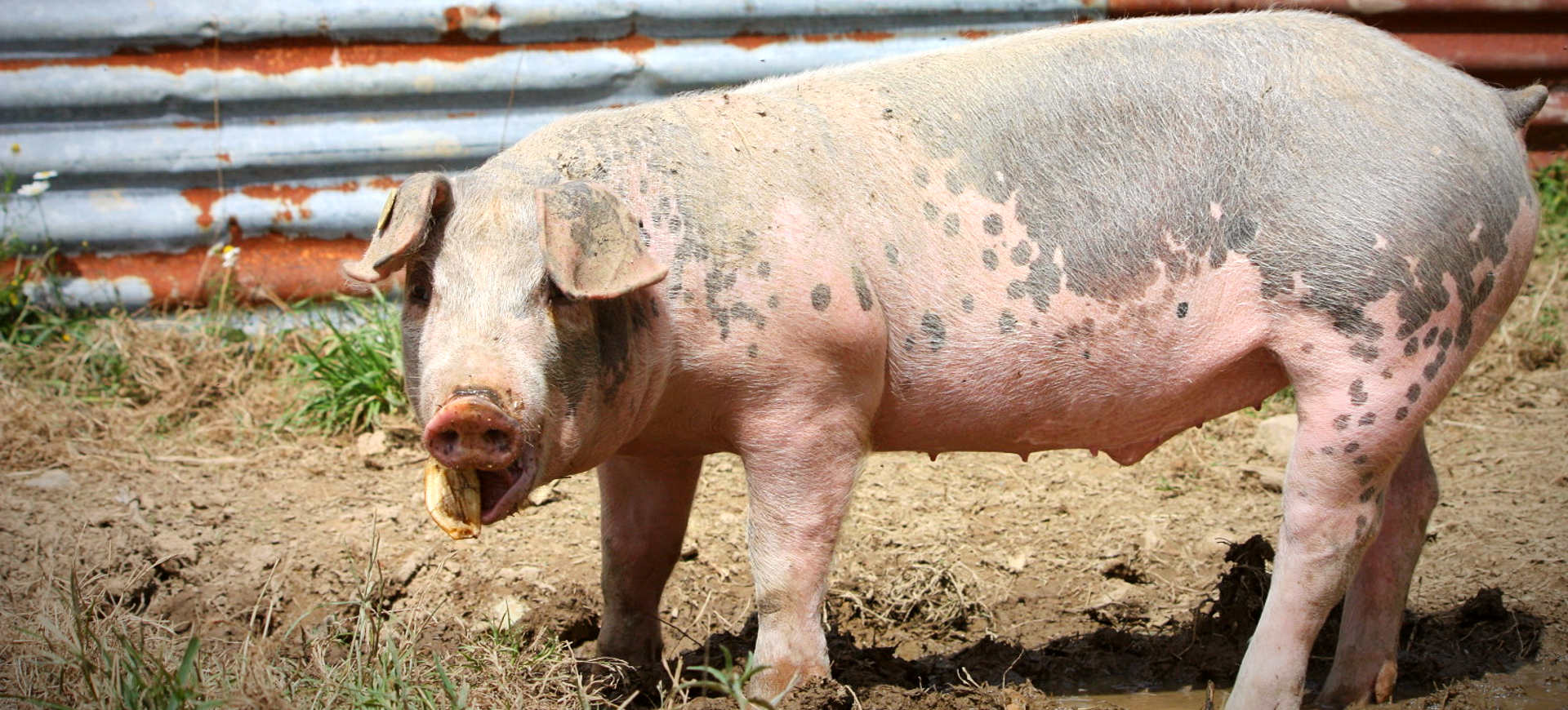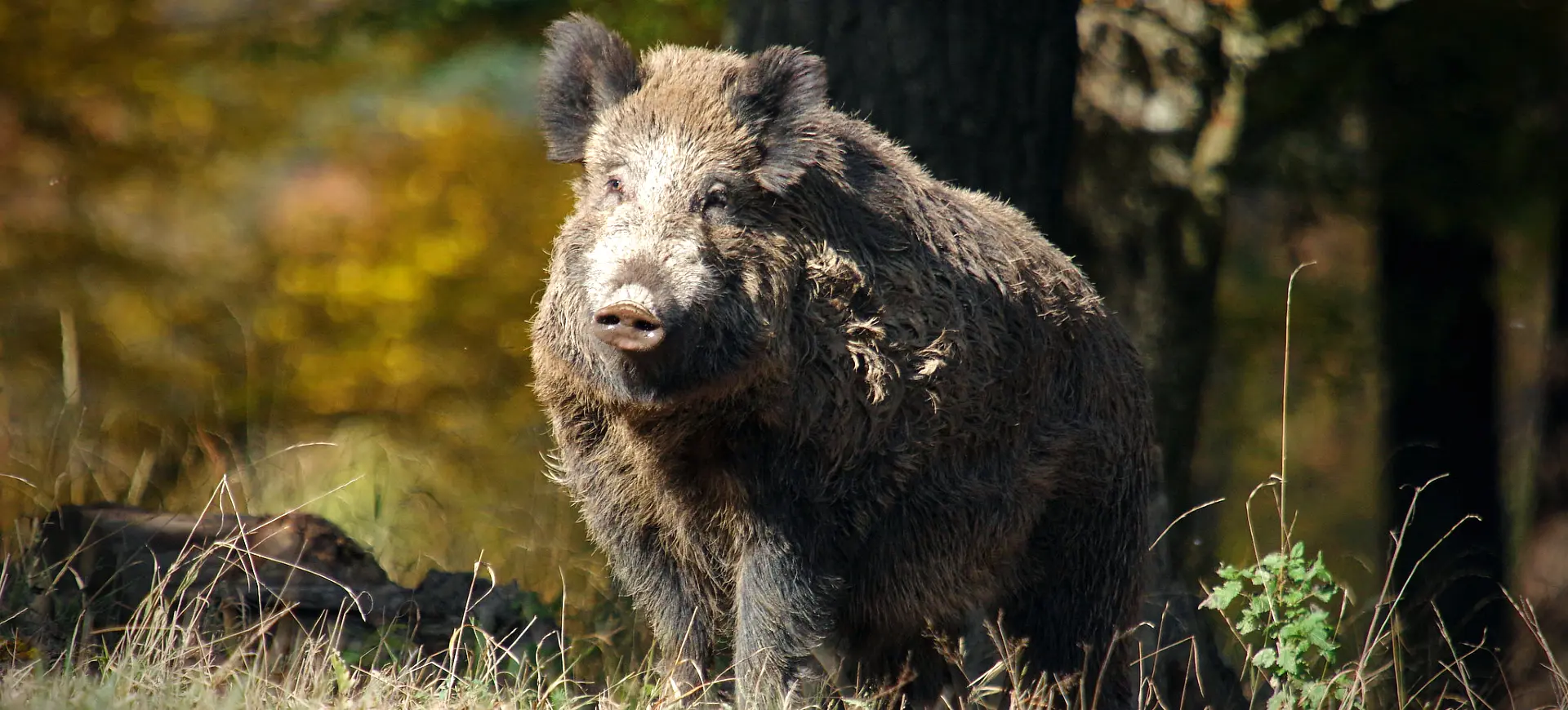Overview
The Common Warthog is a large, African wild pig characterized by its robust build, well-adapted to its harsh environments. One of its most distinguishing features is its large head, which houses elongated facial warts. These warts serve as protective fat reserves and are more prominent in males. The animal also has two pairs of tusks that protrude from its mouth, curving upwards. These tusks are functional for digging and serve as formidable weapons against predators.
The skin of the Common Warthog is mostly sparse and covered with bristles, revealing the greyish-to-brownish skin underneath. This skin is tough and offers some protection against minor abrasions and injuries. Adding to its distinctive appearance, the Common Warthog sports a mane that starts from the top of its head and extends down the length of the spine, terminating roughly at the middle of the back.
Primarily a grazer, the Common Warthog consumes a diet rich in grasses and roots. However, it is an opportunistic omnivore capable of adapting its diet based on availability. When plant-based resources are scarce, such as in the dry seasons, the Common Warthog supplements its diet with fruits, bark, small mammals, and carrion. This adaptability in diet enables it to thrive in various environments across sub-Saharan Africa.
Taxonomy
Kingdom
Phylum
Class
Order
Family
Genus
Species
Sub Species
Type
Physical Description:
The Common Warthog is notably recognized for its robust build, contributing to its adaptability in diverse African terrains. Its large head is another defining characteristic, hosting distinctive facial warts that serve as protective fat reserves, especially in males. These warts also contribute to the warthog’s unique appearance. Adding to its striking look is a mane that starts at the top of its head and extends midway down its back. This mane consists of longer bristles and makes the animal appear larger, especially when it is alarmed or aggressive.
The Common Warthog’s tusks are ornamental and serve specific purposes. The larger, upper tusks are primarily used for digging into the earth for roots or water. Still, they also function as formidable weapons against predators like lions or hyenas. The lower pair of tusks are generally smaller but sharper, serving as effective tools for cutting and shredding. Another physical attribute is its mostly hairless skin, which displays varying shades of grey to brown. The skin is fairly tough, providing some level of protection against the minor scrapes and injuries that the animal might encounter in its environment.

Lifespan: Wild: ~12 Years || Captivity: ~20 Years

Weight: Male: 220–250 lbs (100–113 kg) || Female: 150–180 lbs (68–82 kg)

Length: Male: 59–70 inches (150–180 cm) || Female: 45–55 inches (115–140 cm)

Height: Male: 30–33 inches (76–84 cm) || Female: 25–30 inches (64–76 cm)

Top Speed: 30 mph (48 km/h)
Characteristic:
Native Habitat:
The Common Warthog is native to sub-Saharan Africa, occupying various habitats, including grasslands, savannas, and woodlands. These environments offer the types of food resources the warthog relies on, such as grasses and roots. Water is another crucial element in their habitat selection; they are commonly found in regions where water sources like rivers or lakes are readily available. This is for drinking and wallowing, which helps them regulate body temperature and potentially remove parasites.
In addition to their reliance on water sources, Common Warthogs are known to use natural structures for shelter and protection. Termite mounds and abandoned burrows, often those left by aardvarks, are frequently used as resting places or to escape predators. They are known to modify these structures by digging to make them more suitable for their needs. This adaptation to use existing structures in their environment is another testament to the warthog’s resourcefulness and ability to thrive in varying conditions.
Biomes:
Biogeographical Realms:
Continents:
Countries:
Diet:
Diet & Feeding Habits:
Common Warthogs are primarily grazers, relying on various grasses and roots to make up the bulk of their diet. They use their strong snouts and sharp tusks to dig into the soil, unearthing roots and tubers that are important to their nutritional intake. The species is known for its adaptability when it comes to food sources. This is especially advantageous as they inhabit regions where food availability can fluctuate drastically with the seasons. During plenty, grasses are the mainstay of their diet, but they are also quite adept at rooting out other plant materials beneath the ground.
The dietary habits of the Common Warthog are subject to change depending on environmental conditions. In drier months, when grass and roots become scarce, they exhibit opportunistic eating behaviors. Their diet may include fruits, bark, and even small mammals during such times. This omnivorous flexibility allows them to survive and even thrive in harsh conditions with limited food resources. The ability to diversify their diet is an important factor in their survival across various habitats in sub-Saharan Africa.
Mating Behavior:
Mating Description:
Common Warthogs exhibit a polygynous mating system in reproduction, wherein males engage in competitive behaviors to gain access to receptive females. Males, often called boars, resort to various courtship displays to catch the attention of the females. These displays include behaviors such as chattering their teeth and frequent urination, the latter serving to spread their scent and mark territory. Such rituals are particularly common during the wet season, when food and water are more plentiful, making it a suitable period for mating and subsequent rearing of offspring.
Females, known as sows, also play an active role in mating by signaling their receptivity to potential mates. They do this through vocalizations and body postures indicating their willingness to mate. The timing of these signals usually aligns with the availability of resources, most notably during the wet season. This ensures that the ensuing gestation period and the early life of the offspring coincide with times of relative abundance, thus increasing the chances of survival for the young.
Reproduction Season:
Birth Type:
Pregnancy Duration:
Female Name:
Male Name:
Baby Name:
Social Structure Description:
Common Warthogs are social animals that often form groups known as “sounders,” which typically consist of females and their offspring. These social structures are vital for the animals’ survival, offering protection against predators and facilitating sharing of resources like food and shelter. Within these groups, social interactions are common and reinforce bonds between individuals. Mutual grooming and nose-to-nose greetings are frequent behaviors that help maintain a sense of cohesion and trust among group members.
While females and their young often remain in sounders, adult males generally lead a more solitary existence, especially outside of the mating season. Despite their largely solitary nature, males may temporarily join these social groups during mating season to pursue receptive females. When a male joins a sounder, the dynamic changes as he competes for mating opportunities while participating in social behaviors like grooming and communal feeding. This social flexibility highlights the warthog’s ability to adapt to different social settings based on seasonal and environmental factors.
Groups:
Conservation Status:
Population Trend:
The Common Warthog population is largely stable across much of its range in sub-Saharan Africa. The species exhibits high adaptability and can sustain itself in diverse habitats, including grasslands, savannas, and woodlands. This adaptability allows the warthog to endure environments where other species might struggle. As a result, they are generally less vulnerable to changes in their surroundings, contributing to their relatively stable population numbers.
While the overall population appears secure, localized threats pose challenges to their survival. Habitat fragmentation, often resulting from agricultural expansion and human settlements, can limit their access to essential resources like food and water. Hunting is another concern, as they are sometimes targeted for their meat and tusks. These localized threats can result in pockets of declining populations, warranting targeted conservation efforts to ensure the species’ long-term survival.
Population Threats:
One of the most significant threats facing the Common Warthog population is habitat loss, primarily due to the expansion of agricultural activities. As human settlements grow and farmland encroaches upon natural landscapes, the available habitat for warthogs shrinks, limiting their access to essential resources like food and water. This habitat loss can be particularly detrimental in areas where their natural habitats are already scarce or fragmented, thereby increasing the pressure on the local populations.
Another threat to the Common Warthog is hunting for subsistence and their tusks, which have commercial value. While the species is not currently listed as endangered, ongoing hunting pressures could have a cumulative effect, contributing to localized declines in population numbers. This is especially concerning when coupled with habitat loss, as the combination of these threats could exacerbate the challenges to the long-term stability of their populations. Such threats highlight the need for conservation measures to protect these animals and their habitats.
Conservation Efforts:
Efforts to conserve the Common Warthog focus on a multipronged approach that includes habitat preservation as a central strategy. Maintaining and protecting the natural landscapes where these animals live is crucial for their survival. This includes safeguarding water sources and food supplies and minimizing human encroachment into their habitats. Anti-poaching initiatives are another key aspect of conservation efforts. Through stricter law enforcement, public awareness campaigns, and establishing protected areas, authorities aim to curb the illegal hunting of warthogs for their meat and tusks.
Community-based conservation projects have also proven effective in certain regions, leveraging local knowledge and stakeholder engagement to preserve warthog populations. In these initiatives, local communities are often provided with economic incentives or educational programs that encourage protection rather than hunting these animals. This helps sustain the local warthog populations and fosters a sense of stewardship among community members. Such community involvement is increasingly recognized as a vital component in the long-term success of conservation efforts for the Common Warthog.
Additional Resources:
Fun Facts
- Common Warthogs can run at speeds up to 30 mph.
- They are excellent swimmers.
- Despite their fierce appearance, they are generally not aggressive unless provoked.
- They often use their tusks and snouts to dig for food.
- Common Warthogs are known to kneel on their front legs while feeding.
- They can go for several months without water during the dry season.
- They frequently use burrows made by other animals for shelter.
- Their large tusks are used both for defense and for digging.
- Males are called boars, females are called sows, and their young are called piglets.
- They have a varied vocal repertoire, including grunts, snorts, and squeals.









